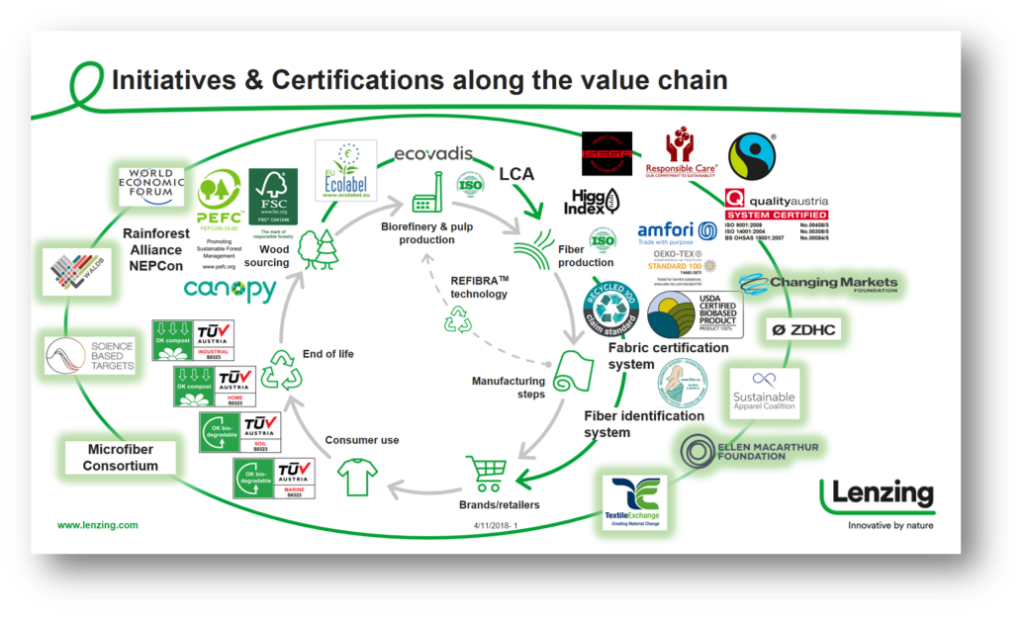
What are science-based targets? Why science-based targets?
Since Lenzing established its Sustainability department some years ago, the demands on the team have grown exponentially. Customers, stakeholders and NGOs all request information and action on a multitude of environmental subjects important to them – water, energy, chemicals, greenhouse gases, forestry, biodegradability, microfiber pollution – and the list goes on.
This illustration shows the breadth of certifications and initiatives that the team has to deal with from day-to-day.

In light of this burden, it has become important recently to prioritize the issues that are the most environmentally pressing, and the issue front and center of most urgency is carbon reduction.
The phrase “global warming” has become familiar to many people as one of the important environmental issues of our day. Many opinions have been expressed about it, ranging from the doom-laden to the dismissive.
At Lenzing, we’re committed to make an impact in reducing global warming. Read on to learn more about climate change and how science-based targets are being used to address this environmental challenge.
Short History of Global Warming
Our understanding of how certain atmospheric gases trap heat dates back almost 200 years to 1824, when Joseph Fourier described what we know as the greenhouse effect. Fourier, a French mathematician and physicist, asked what seem to be simple questions: Why doesn’t the planet keep heating up as it receives sunlight? What is regulating our atmospheric temperature?
Knowing that heated surfaces emit radiation (thermal energy), Fourier reasoned that the Earth would emit radiation absorbed by the sun back into space – resulting in an icy planet. There must be something regulating the temperature, emitting enough thermal energy to keep the planet from freezing and overheating. Not too hot, not too cold.
Fourier tried to explain his insight by comparing the Earth with its covering of air to a box with a glass cover. People took up his analogy, and the trapping of heat by the atmosphere eventually came to be called “the greenhouse effect.”
In 1862, John Tyndall discovered that certain gases (water and carbon dioxide) help trap heat from escaping the atmosphere. Seen in retrospect, he is a critical figure in the history of climate science.

By 1895, Swedish chemist Svante Arrhenius became curious about how decreasing levels of CO2 in the atmosphere might cool Earth. Scientists already knew that volcanoes could spew vast amounts of greenhouse gas, so Arrhenius wondered if a long period of volcanic quiet might allow carbon dioxide levels to draw down and perhaps help plunge Earth into an ice age. His calculations showed that if CO2 levels were halved, global temperatures could decrease by about 5 degrees Celsius (9 degrees Fahrenheit).
Next, Arrhenius wondered if the reverse were true. He returned to his calculations, this time investigating what would happen if CO2 levels were doubled. The possibility seemed remote at the time, but his results suggested that global temperatures would increase by the same amount—5 degrees C or 9 degrees F.
Decades later, modern climate modeling has confirmed that Arrhenius’ numbers weren’t far off the mark. In fact, scientists now use a doubling of CO₂ as a reference point for comparing computer models and a benchmark for where our atmosphere might stand by 2050.
Where Arrhenius was mistaken was that he underestimated the pace of global development, figuring it would take until the year 4000 or so for his projected doubling to occur. He also suggested increased CO2 levels might be beneficial for future generations.
Fast forward to 1989, when the Intergovernmental Panel on Climate Change (IPCC) was established under the United Nations to provide a scientific view of climate change and its political and economic impacts.
In 1997, the first global agreement to reduce greenhouse gases was adopted in the form of the Kyoto Protocol.
In 2001, the IPCC issued its third report on climate change, saying that global warming, unprecedented since the end of the last ice age, is “very likely,” with highly damaging future impacts.
Five years later, former Vice President Al Gore weighed in on the dangers of global warming with the debut of his film, “An Inconvenient Truth.” Gore won the 2007 Nobel Peace Prize for his work on behalf of climate change.
In 2015, 195 countries pledged to set targets for their own greenhouse gas cuts and to report their progress at the Paris Climate Agreement; this was aimed at preventing a global temperature rise of 2 degrees C.
In 2018, Swedish teenager and climate activist Greta Thunberg began protesting in front of Swedish Parliament with a sign: “School Strike for Climate.” Her protest to raise awareness for global warming had, by November 2018, resulted in more than 17,000 students in 24 countries participating in climate strikes.
Today there is a general consensus that the eventual extent of global warming is proportional to the total amount of carbon dioxide (CO2) that human activities add to the atmosphere. Therefore, in order to stabilize climate change, CO2 emissions need to fall to zero. The longer it takes to do so, the more the climate will change. Emissions of other greenhouse gases also need to be constrained.
In the Paris Agreement, governments agreed to keep global warming “well below” 2 degrees Celsius, and to “make efforts” to keep it below 1.5 degrees C. The IPCC released a report in October 2018 on the 1.5°C target; it concluded that global emissions needed to reach net zero around mid-century to give a reasonable chance of limiting warming to 1.5ºC.
It would seem that we are not on track to meet climate change targets. Adding up all the promises to cut emissions made by countries that are party to the Paris climate agreement, the world would still warm by more than 3°C by the end of this century.

According to the UN Global Compact, climate change is the defining issue of our time — and we appear to be at a pivotal moment. They claim however that there is still time to get the world back on track, but to do that actions need to be bolder. That is why they are calling on business to step up and commit to setting science-based targets aligned with limiting global temperature rise to 1.5°C above pre-industrial levels.
Leading companies are reported as already proving that a 1.5°C-compliant business model is possible, and there is evidence that these companies will be best placed to thrive as the global economy undergoes a just transition to a net-zero future by 2050.
What are SBTs?
Science-based targets are a set of goals developed to provide guidance on a clear route to reduce greenhouse gas emissions. An emissions reduction target is defined as “science-based” if it is developed in line with the scale of reductions required to keep global warming below 2°C from pre-industrial levels.
In order to scale up the adoption of these goals, the Science Based Targets initiative (SBTi) was formed toward the end of 2015 through a joint partnership between the Carbon Disclosure Project (CDP), UN Global Compact (UNGC), World Resources Institute (WRI) and World Wildlife Fund (WWF).
The initiative provides a systematic guide to the implementation of science-based targets. Firstly, businesses are asked to sign a commitment letter that indicates a pledge to set a science-based target. After submitting a commitment letter, your company will be recognized as “Committed” on the Companies Taking Action webpage as well as on the partner websites such as We Mean Business and CDP. Companies who are engaging in the UN Global Compact will also be recognized on the UNGC website.
Companies then have up to 24 months to fully develop the goal(s). For the best chance of approval, the target has to meet the SBTi’s criteria – the latest being SBTi Criteria (4.0), which offers companies two temperature goal options: 1.5 degrees and well-below 2 degrees. Once a target has been developed, a company needs to send a “Target Submission Form.” This form will then be verified by the Science Based Targets initiative, which will confirm whether the target has been formally approved or requires additional work.
On confirmation that your target meets the SBTi criteria, your company and its target will be showcased on the Science Based Targets website and in other communications and you will be able to use the SBT logo on your website and communications.
As part of the criteria for setting a science-based target, the target boundary must be company-wide. This means covering all emissions included in the Greenhouse Gas Protocol and including both Scope 1 and Scope 2 emissions. Companies are also required to disclose their greenhouse gas emissions on an annual basis along with any other data that shows progress against their targets.
Emissions are broken down into three categories by the Greenhouse Gas Protocol.
Scope 1 – All Direct Emissions.
This means all activities of an organization or under their control.
Scope 2 – Indirect Emissions.
For example, electricity purchased and used by the organization – emissions that are created during the production of such energy and subsequently used by the organization.
Scope 3 – All Other Indirect Emissions.
Activities occurring from sources that the organization do not own or control. These are usually the greatest share of the carbon footprint, covering emissions associated with business travel, procurement, waste and water.

One important point within the Science Based Target initiative criteria is that offsets are not allowed, as they do not result in a real reduction in emissions. The target of all companies is to decarbonize by 2050, and that’s where they are encouraged to focus their efforts.
As of April 2020, 850 companies are taking science-based climate action and 350 companies have approved science-based targets. Lenzing is one of those companies who have received approval for their action plan.
Lenzing is the world’s first producer of wood-based cellulosic fibers to make a strategic commitment to dramatically reduced its carbon footprint and cut its emissions per ton of product by 50 percent by 2030. The climate target represents an important component of Lenzing’s strategy. The vision and the plan is to achieve net zero carbon emissions by 2050.
So when assessing the suitability of your wood-based cellulosic supplier, of all the certifications and standards that you are considering, the one that should be the first on your list and is of paramount importance to everyone’s future is a carbon reduction strategy.






